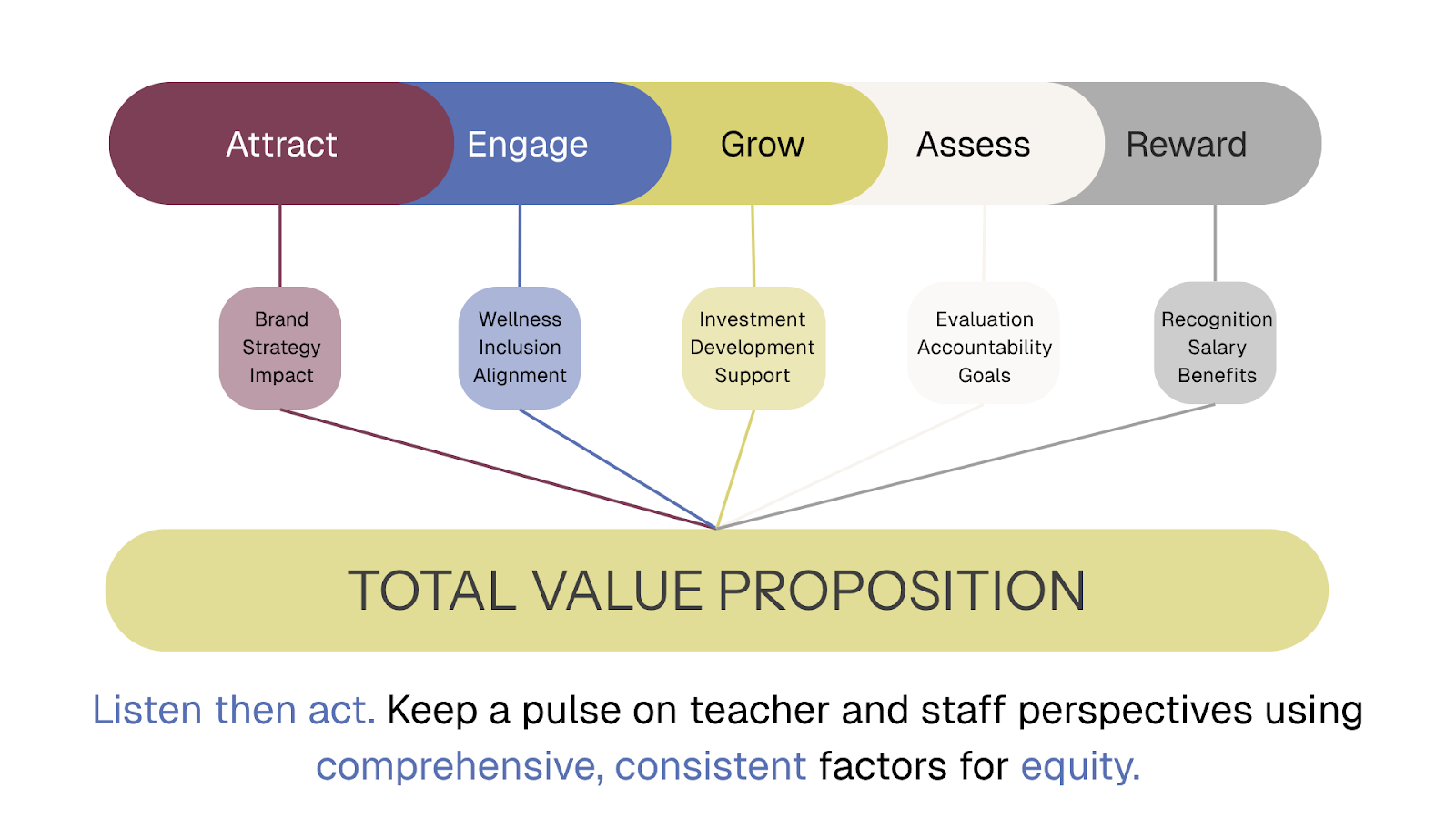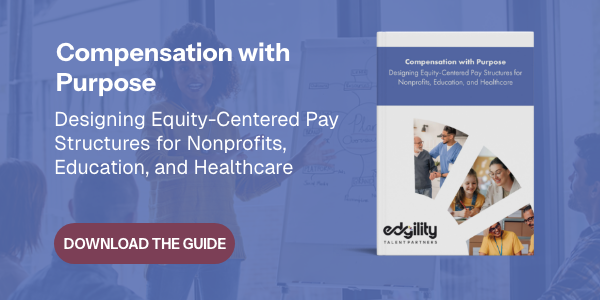Every spring, charter school teachers and leaders face one of the most critical human resources challenges of the year: contract season. Between March and July, schools must confirm which teachers and staff are returning, issue renewal letters, and backfill vacant positions; all within a short, high-stakes window that demands focus and coordination.
For many charter schools, this compressed timeline leaves little room for error. Without a clear, equitable teacher compensation program in place, schools risk staffing gaps, rushed hiring decisions, and the loss of valuable full-time educators.
Fall and early winter are the ideal times to re-evaluate your compensation approach so you can enter contract season with clarity, confidence, and data to guide your decisions.
1. Understand What’s at Stake
When compensation planning doesn’t happen early enough, schools face predictable, but avoidable challenges. Staffing gaps, rushed hiring processes, and inequitable pay practices can erode trust and retention across elementary school, middle school, and high school campuses alike.
Charter schools typically retain about 80–90% of staff each year, meaning they may need to backfill up to 20% of roles between March and August. The more clarity and consistency you bring to your teacher compensation planning now, the smoother your staffing cycle will be later.
2. Gather Input from Staff, and Listen Closely
Before making pay decisions, gather insights from the people most affected by them. Talk to both current and departing teachers to understand what’s working, what isn’t, and where your school can improve.
- Surveys: Conduct an annual survey to capture employee perspectives on pay, benefits, paid time off (PTO), and overall satisfaction.
- Exit interviews: Use these to identify trends behind turnover and learn why staff, including teachers, administration, or other instructors, are choosing to leave.
- Focus groups and leadership 1:1s: When possible, partner with an external consultant to lead these sessions. Teachers and staff are often more candid with a neutral third party, and outside facilitation helps uncover honest, actionable insights.
These conversations help your human resources team and leadership align compensation with reality, not assumptions.
3. Test for internal Pay Equity
Before looking outward to the market, leaders should first look inward and ask: “Are we paying our school staff equitably?” Even with the best intentions, pay gaps can develop in subtle ways.
Where we see most inequities emerge are in the following two key areas:
Starting salaries for new hires
Teachers who negotiate more aggressively can sometimes start higher on the pay scale than equally qualified peers. Reviewing how new hires are placed on the step scale helps ensure consistency across years of experience, credentials, and role expectations.
Stipends and additional responsibilities
Extra duties, such as leading after-school programs, mentoring new teachers, or coordinating testing, should be compensated fairly based on time and responsibility. For example, a teacher dedicating one extra hour a week should not earn the same stipend as another who spends five.
To assess whether pay is equitable, consider not just the amount of salary, but what goes into that decision:
- Are pay differentials driven by objective criteria such as educational credentials, teaching certifications, or levels of mastery?
- Are stipend opportunities distributed equitably across grade levels, subject areas, and staff demographics?
- Are you accounting for the length of your school year, which may differ from other schools in your region and impact comparability?
Leaders should also evaluate whether compensation is competitive across education levels. You might be highly competitive for teachers with bachelor’s degrees, but fall behind for those with master’s or doctoral degrees (PhDs).
Finally, communicate with staff about how they can grow their compensation over time, and whether through additional credentials, leadership roles, or exceptional performance. Transparency about pathways to higher pay not only builds trust but also strengthens retention.
4. Study the Market
Your compensation program doesn’t exist in a vacuum. To stay competitive and fair, you need to understand both your local school district and the broader education landscape.
Start by looking at what’s happening in your area:
District negotiations
Many public school teachers are represented by unions, and recent collective bargaining agreements can significantly shift market rates. For example, in 2022, the Los Angeles Unified School District (LAUSD) and United Teachers Los Angeles (UTLA) negotiated roughly 21% salary increases over three years (2022–2025). This pushed the average salary for new teachers from about $58,000 to roughly $68,000 in annual salary, reshaping the regional market.
Comparable schools
Review the salary ranges and pay ranges of neighboring charter schools, public schools, and private schools to understand how your pay compares.
Once you know where you stand, whether you’re above, below, or at market, you can make informed decisions about where you want to be, given your budget, values, and staff's years of experience.
5. Define (or Refine) Your Compensation Philosophy
Your teacher compensation philosophy is the foundation of every pay decision you make. It should clearly express your school’s values, your approach to the market, and how you reward growth and professional development.
If you don’t already have one, this is the time to define it. A strong philosophy will:
- Articulate your school’s core values related to pay and benefits
- Outline your approach to market positioning (e.g., “we pay at market” or “we aim to lead market rates”)
- Define how salaries are determined by job title, how raises are awarded, and how additional work is recognized through stipends or bonuses
If you already have a compensation philosophy, review it to ensure it still reflects your current practices. Most updates are minimal but essential to maintain alignment and trust among charter school teachers and staff.
Make your compensation philosophy clear, equitable, and actionable: Download Edgility’s Compensation Philosophy Worksheet
6. Refine Your Compensation Program
Once your philosophy is clear, it’s time to ensure your program supports it.
If you don’t have a compensation program in place, this is a significant but worthwhile investment. Most charter schools begin this work in the fall, after securing partnership with a compensation consultant firm in the spring.
If your program already exists, evaluate whether your salary structures need adjustment:
- When the budget allows, align salary ranges with current market data and internal pay equity principles. In years without a full benchmarking study, apply a flat increase based on the cost of living and the cost of labor. In years with new market data, make targeted adjustments for roles that have fallen behind.
- When budgets are limited, use targeted retention levers to support the staff groups most at risk of turnover.
Ask: Where are we losing the most people?
- If it’s teachers: Update your salary structure to ensure you’re as competitive as possible, revisit your stipend and paid time off policies, and review staff feedback for low-cost retention options.
- If it’s entry-level staff: Consider implementing a living wage floor—the minimum pay required to meet basic needs in your area. Use tools like MIT’s Living Wage Calculator or estimate based on median rental costs.
For all staff, review benefits such as life insurance, retirement contributions, and professional development funds to ensure they align with your philosophy.
7. Communicate, Communicate, and Communicate More
Transparency is the final, and most crucial, step. Even the most thoughtful pay changes can backfire if they’re not clearly explained.
- Make policies accessible: Store pay scales, benefits, and policy documents in a central location accessible to all school teachers and staff.
- Share updates verbally and in writing: Reinforce key messages in offer letters, 1:1 meetings, and team sessions.
- Explain the “why.” Without context, staff will fill in the blanks themselves. Clearly communicating why changes were made (and why others weren’t) builds trust across every level—from elementary school aides to high school teachers.
- Support your managers: Provide an FAQ or talking points to help leaders navigate questions about pay or PTO.
In compensation planning, more communication is always better. Clear, consistent messaging ensures your teachers feel informed, respected, and valued.
How to Prepare for What’s Next
Spring contract season moves fast. The schools that prepare early in the fall are the ones that enter renewal season with stability and confidence.
If you haven’t yet reviewed your compensation philosophy or pay structures, start planning now for next year. Most charter schools partner with Edgility Talent Partners in the spring to begin the work in the fall, ensuring their systems are equitable, competitive, and sustainable.
Ready to Prepare for Contract Season with Confidence?
Read and download your own copy of the eBook, Compensation with Purpose: Designing Equity-Centered Pay Structures for Nonprofits, Education, and Healthcare, and learn how to build pay systems that reflect your mission, strengthen trust, and sustain your people for the long term.






